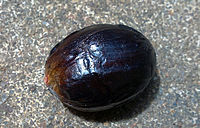
| |

| |

| |
| Names | |
|---|---|
| Systematic IUPAC name
Propane-1,2,3-triyl tri(tetradecanoate) | |
| Other names | |
| Identifiers | |
3D model (JSmol)
|
|
| ChemSpider | |
| ECHA InfoCard | 100.008.273 |
| EC Number |
|
PubChem CID
|
|
| UNII | |
CompTox Dashboard (EPA)
|
|
| |
| |
| Properties | |
| C45H86O6 | |
| Molar mass | 723.177 g·mol−1 |
| Appearance | White-yellowish gray solid |
| Odor | Odorless |
| Density | 0.862 g/cm3 (20 °C)[4] 0.8848 g/cm3 (60 °C)[2] |
| Melting point | 56–57 °C (133–135 °F; 329–330 K) at 760 mmHg[2][4][5] |
| Boiling point | 311 °C (592 °F; 584 K) at 760 mmHg[2] |
| Solubility | Slightly soluble in alcohol, ligroin Soluble in diethyl ether, acetone, benzene,[2] dichloromethane, chloroform, TBME |
Refractive index (nD)
|
1.4428 (60 °C)[2] |
| Structure | |
| Triclinic (β-form)[3] | |
| P1 (β-form)[3] | |
a = 12.0626 Å, b = 41.714 Å, c = 5.4588 Å (β-form)[3] α = 73.888°, β = 100.408°, γ = 118.274°
| |
| Thermochemistry | |
Heat capacity (C)
|
1013.6 J/mol·K (β-form, 261.9 K) 1555.2 J/mol·K (331.5 K)[5][6] |
Std molar
entropy (S⦵298) |
1246 J/mol·K (liquid)[6] |
Std enthalpy of
formation (ΔfH⦵298) |
−2355 kJ/mol[6] |
Std enthalpy of
combustion (ΔcH⦵298) |
27643.7 kJ/mol[6] |
| Hazards | |
| NFPA 704 (fire diamond) | |
| Flash point | > 110 °C (230 °F; 383 K)[7] |
| 421.1 °C (790.0 °F; 694.2 K)[7] | |
Except where otherwise noted, data are given for materials in their standard state (at 25 °C [77 °F], 100 kPa).
| |
Trimyristin is a saturated fat and the triglyceride of myristic acid with the chemical formula C45H86O6. Trimyristin is a white to yellowish-gray solid that is insoluble in water, but soluble in ethanol, acetone, benzene, chloroform, dichloromethane, ether, and TBME.
Occurrence
Trimyristin is found naturally in many vegetable fats and oils.
Isolation from nutmeg

The isolation of trimyristin from powdered nutmeg is a common introductory-level college organic chemistry experiment.[8][9] It is an uncommonly simple natural product extraction because nutmeg oil generally consists of over eighty percent trimyristin. Trimyristin makes up between 20-25% of the overall mass of dried, ground nutmeg. Separation is generally carried out by steam distillation and purification uses extraction from ether followed by distillation or rotary evaporation to remove the volatile solvent. The extraction of trimyristin can also be done with diethyl ether at room temperature, due to its high solubility in the ether. The experiment is frequently included in curricula, both for its relative ease and to provide instruction in these techniques. Trimyristin can then be used to prepare myristic acid[10] or one of its salts[11] as an example of saponification.
See also
References
- ^ Merck Index, 11th Edition, 9638.
- ^ a b c d e f Lide, David R., ed. (2009). CRC Handbook of Chemistry and Physics (90th ed.). Boca Raton, Florida: CRC Press. ISBN 978-1-4200-9084-0.
- ^ a b c d Van Langevelde, A.; Peschar, R.; Schenk, H. (2001). "Structure of β-trimyristin and β-tristearin from high-resolution X-ray powder diffraction data". Acta Crystallographica Section B. 57 (3): 372–377. doi:10.1107/S0108768100019121. PMID 11373397.
- ^ a b Sharma, Someshower Dutt; Kitano, Hiroaki; Sagara, Kazunobu (2004). "Phase Change Materials for Low Temperature Solar Thermal Applications" (PDF). Res. Rep. Fac. Eng. Mie Univ. 29. Mie University: 31–64. Retrieved 2014-06-19.
- ^ a b Charbonnet, G. H.; Singleton, W. S. (1947). "Thermal properties of fats and oils". Journal of the American Oil Chemists' Society. 24 (5): 140. doi:10.1007/BF02643296. S2CID 101805872.
- ^ a b c d Trimyristin in Linstrom, Peter J.; Mallard, William G. (eds.); NIST Chemistry WebBook, NIST Standard Reference Database Number 69, National Institute of Standards and Technology, Gaithersburg (MD) (retrieved 2014-06-19)
- ^ a b c "MSDS of Trimyristin". fishersci.ca. Fisher Scientific. Retrieved 2014-06-19.
- ^ Frank, Forrest; Roberts, Theodore; Snell, Jane; Yates, Christy; Collins, Joseph (1971). "Trimyristin from nutmeg". Journal of Chemical Education. 48 (4): 255. Bibcode:1971JChEd..48..255F. doi:10.1021/ed048p255.
- ^ Vestling, Martha M (1990). "Isolation of trimyristin and cholesterol: Two microscale extractions for one laboratory period". Journal of Chemical Education. 67 (3): 274. Bibcode:1990JChEd..67..274V. doi:10.1021/ed067p274.
- ^ Beal, G. D. (1926). "Myristic Acid". Organic Syntheses. 6: 66. doi:10.15227/orgsyn.006.0066.
- ^ De Mattos, Marcio C. S; Nicodem, David E (2002). "Soap from Nutmeg: An Integrated Introductory Organic Chemistry Laboratory Experiment". Journal of Chemical Education. 79 (1): 94. Bibcode:2002JChEd..79...94D. doi:10.1021/ed079p94.









